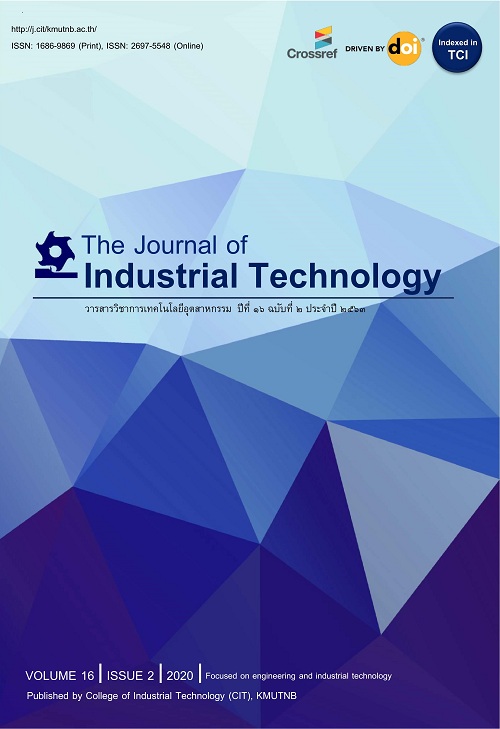The Work Station Improvement by Ergonomics Principle to Reduce Fatigue from Work of Worker’s in Smoked Rubber Sheets Processing
การปรับปรุงสถานีงานตามหลักการยศาสตร์เพื่อลดความเหนื่อยล้าในการทำงานของพนักงานโรงงานผลิตยางแผ่นรมควัน
Abstract
การวิจัยนี้มีวัตถุประสงค์เพื่อศึกษาปัญหาสุขภาพ ความเสี่ยงทางการยศาสตร์และความเหนื่อยล้าในการทำงาน ก่อนและหลังการออกแบบปรับปรุงสถานีงาน โดยเปรียบเทียบจากปัจจัยส่วนบุคคลและปัจจัยสภาพแวดล้อม ตัวอย่างคือพนักงานโรงงานผลิตยางแผ่นรมควัน สหกรณ์กองทุนสวนยาง ตำบลไม้เรียง อำเภอฉวาง จังหวัดนครศรีธรรมราช ผลการศึกษาปัญหาสุขภาพ พบค่าดัชนีความผิดปกติ (AI) มีค่าที่ต้องเอาใจใส่และระมัดระวัง และเป็นค่าที่รับไม่ได้ให้แก้ไขทันที ผลการศึกษาภาระงานต่อกล้ามเนื้อ พบว่ามีความเสี่ยงต่อสุขภาพสูง ส่วนผลการศึกษาความเสี่ยงทางการยศาสตร์ ก่อนปรับปรุง จากการประเมินด้วยวิธี RULA มีค่าเฉลี่ย 10 ส่วนวิธี REBA มีค่าเฉลี่ย 13 หมายถึงมีระดับปัญหาทางการยศาสตร์ที่ควรทำการปรับปรุง ส่วนผลการศึกษาความเหนื่อยล้าด้วยแบบสอบถามของไปเปอร์ ก่อนปรับปรุง มีคะแนนเฉลี่ยรวมทุกด้าน 139 คะแนน มีค่าเฉลี่ย 6.32 แสดงว่าพนักงานมีความเหนื่อยล้าระดับปานกลาง จากการนำเสนอแนวทางการปรับปรุงสถานีงานโดยการออกแบบอุปกรณ์ลำเลียงยางแผ่นซึ่งใช้ข้อมูลขนาดสัดส่วนร่างกายตัวอย่าง ปัจจัยส่วนบุคคลและปัจจัยสภาพแวดล้อม ประกอบการปรับปรุงผลการประเมินอุปกรณ์จากผู้เชี่ยวชาญ/ผู้ชำนาญการ โดยรวมมีค่าเฉลี่ย 4.20 ซึ่งอยู่ในระดับความเหมาะสมมาก ผลการเปรียบเทียบก่อนและหลังการปรับปรุง พบว่าการประเมินด้วยวิธี RULA จากเดิม มีค่าเฉลี่ย 10 ลดเหลือ 7 สอดคล้องกับผลการประเมินด้วยวิธี REBA จากเดิม มีค่าเฉลี่ย 13 ลดเหลือ 6.67 ซึ่งหมายถึงงานนั้นยังมีปัญหาที่ควรทำการศึกษาเพิ่มเติมและปรับปรุงลักษณะงานดังกล่าวต่อไป ส่วนผลการศึกษาความเหนื่อยล้า ก่อน-หลัง การปรับปรุง จากเดิม ค่าเฉลี่ย 6.32 ลดเหลือ 4.80 โดยผลการเปรียบเทียบการประเมินความเหนื่อยล้าพบว่ามีค่าระดับคะแนนลดลงซึ่งเป็นผลมาจากการปรับปรุงสถานีงานตามหลักการยศาสตร์
This research aimed to assess health problems, ergonomics, and fatigue from work to improve workstations by comparing personal and environmental factors and comparing the ergonomics risk and fatigue from work before and after improving the workstation. The sample comprises workers in a rubber smoked sheet processing factory from Maireang rubber plantation fund cooperation in Chawang District, Nakhonsithammarat Province. The results showed that the Abnormality Index (AI) score was a value to be careful of and it is an unacceptable value. So, it must be corrected immediately. It should improve the workstation, meanwhile, the mean value of RULA was 10, while the REBA was 13, indicating ergonomic problems that required workstation improvement. The Piper fatigue assessment indicated a score of 139 and an average of 6.32, signifying that the worker experienced moderate levels of fatigue from work. From presenting a guideline to improve the workstation by designing a rubber sheet conveying tool that uses the body size data of the sample. Personal factors, environmental factors, and tool evaluation results of experts in terms of an average of 4.20 which is a very reasonable level. The results showed that fatigue and work-related risks, assessed by ergonomic principles, decreased from a RULA score of 10 to 7 and a REBA score from 13 to 6.67. This indicates that there are still unresolved issues in the work environment that require further investigation and improvement. The score was an average of 6.32 down to 4.80. By comparing the results, there was a decrease in the score level due to improvements made to the workstation based on the ergonomics principle.
Keywords
[1] V.G. Duffy, The impact of organizational ergonomics on work effectiveness, Ergonomics, 1999, 42, 614-637.
[2] K.Sutida, Indication and ergonomics task analysis for work condition improvement, Security Development Department, Institute for Occupational Safety Development, 2011. (in Thai)
[3] J. Yupaporn, C. Chawapornpan, and T. Wanpen, Health status and health preventive behaviors among rubber plantation workers, The Journal Public Health, 2007, 3(1), 1-10. (in Thai)
[4] A. Prapatsorn, S. Weeraporn, and L. Waraporn, Occupational health hazards and health status related to risk among workers in a smoked rubber sheet plan, Nursing Journal, 2012. 39(3), 27-37. (in Thai).
[5] Muscle aches due to work and improvement of working conditions, Thailand Institute of Occupational Safety Department of Labor Protection and Welfare, 2008. (in Thai)
[6] L. McAtamney and E.N. Corlett, RULA: a survey method for the investigation of work-related upper limb disorders, The Journal Applied Ergonomics, 1993, 24(2), 91-99.
[7] S. Hignett and L. McAtamney, Rapid Entire Body Assessment (REBA), The Journal Applied Ergonomics, 2000, 31(2), 201-205.
[8] V. Carrieri-Kohlman, A.M. Lindsey, C.M. West, Pathophysiological phenomena in nursing: Human responses to illness, 2nd ed., WB Saunders, PA, USA, 1993, 279-302.
[9] M. Weerachai. H. Rungsima, S. Mukda, and S. Angoon, The health problem and workload on muscles of worker’s in smoked rubber sheets processing, Thai Research Higher Education Institution Network Thailand International Conference, Proceeding, 2021, 337-343.
[10] S.T. Pheasant, Antropromatry, ergonomics and design, Taylor Francis, London, UK, 1988.
[11] M. Weerachai, H. Rungsima, and S. Angoon, Anthropometry for work station improvement design of worker’s in smoked rubber sheets processing, Research NCAME Thailand International Conference, Proceeding, 2023, 76.
[12] J.T. Black, Design and implementation of lean manufacturing systems and cells, In: S.A. Lrani, (Ed.), Handbook of cellular manufacturing system, Wiley & Sons, NY, USA, 1999, 453-496.
[13] R. Likert, The Human organization: Its management and value, McGraw- Hill, NY, USA, 1976.
DOI: 10.14416/j.ind.tech.2024.08.012
Refbacks
- There are currently no refbacks.






